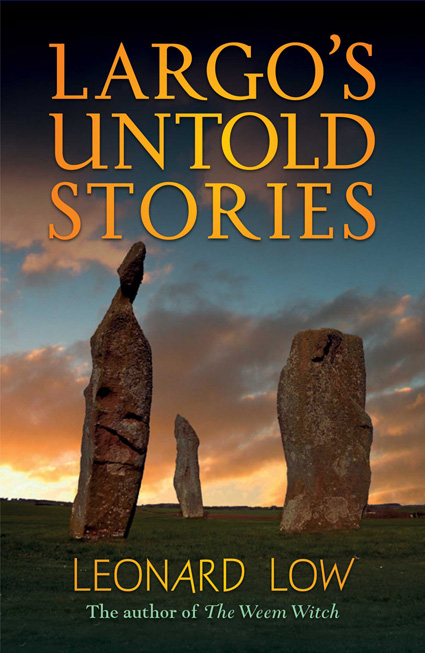home our books a-z ordering contact us search links news |

 | Largo's Untold Stories
Leonard Low |
| sample extract... |
Largo Bay, with its horseshoe shape, has sand dunes around its circumference, with coarse grass behind. A light gradient leads us down the golden sandy beach stretching for a hundred yards or more in places. In the summer on a decent day you can actually think you're in a Mediterranean surrounding -- until your toes dip into the first inch of the sea and your mind is instantly transported to the Baltic.
There are rocky outcrops here which are fantastic for crab hunters, and at low tide herons and seals can be seen to soak up the summer rays and steal a meal where available. It is a tranquil place, full of dog walkers, golfers practising their swing; brave swimmers in the summer months will come from afar to enjoy the water, and ramblers meander along the sands, walking off into the distance.
It is nature at its unspoilt best: gulls overhead cry and dive headlong into the sea, catching a few of the swarms of sand eels at the turn of the tide. Small armies of oystercatchers march up and down the sands at low tide digging in the sand for food. Littered all along the seafront are volcanic bombs, huge rounded stone deposits blown from an erupting Largo Law. The stones tell of its volcanic violence many millennia ago, ranging from cannonball size to ten tonnes in weight. Almost 290 metres high, the volcano is now extinct.
At sea, there is a small, shimmering fleet of yachts. They twist and turn, using their sails to gain a purchase on what wind is available. Occasionally in the sky a one-man microlight aircraft will fly overhead with the hum of an angry bee, navigating the air currents and eventually landing on the hard flat sands. In the distance across the water lies the May Island, a bird sanctuary now, but still sitting watching over the Firth of Forth with its little sister the Bass Rock, its cliffs white from centuries of gull guano.
Occasionally in winter months, after a storm, if the conditions are right, the sands in the bay can shift completely. Thousands of tonnes of sand will disappear overnight, and then the bare rock is exposed, revealing fantastic fossils -- ferns, trees and small shells embedded into the prehistoric rock, laid naked by the migrating sand for a brief moment. Here interested local geologists find evidence that in the distant past, in the Jurassic era, the bay was once a forest. This exposure has to be admired and recorded quickly, for after a few full tides the sands will gradually return. In a matter of weeks the bay will regain its golden sheen.
It happened in 1965. The skies overhead darkened heavily, the winter storm came, the north wind blew, and waves smashed and tore at the beach in a terrible fury that lasted for days. Once the danger had passed and the storm had lost its power, it was noticed the golden sands had shifted; the black rock was laid bare. Fossils were showing once again. But this time the wild storm that displaced the sands exposed something else, something new -- the bones of two feet!
The two feet were still attached to a skeleton, buried further into the sand... |
|

